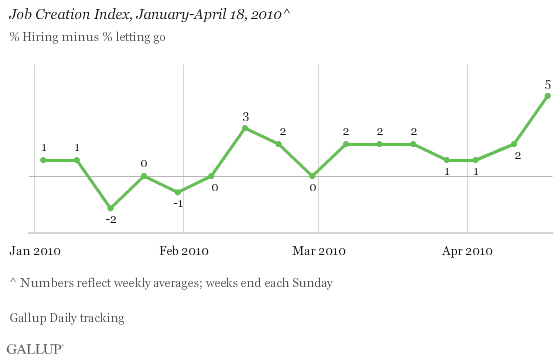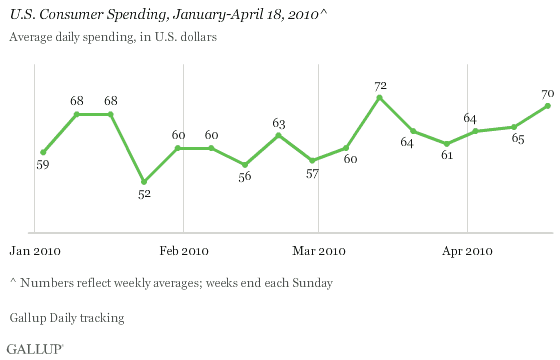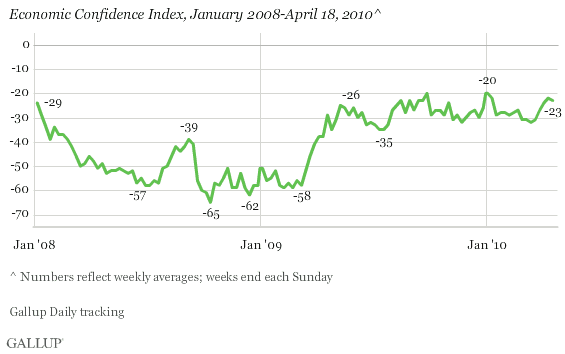PRINCETON, NJ -- Gallup estimates that more than 1.5 million Americans who were underemployed became employed to full capacity over the last month. Gallup's 30-day average underemployment measure (not seasonally adjusted) declined to 19.2% on April 18 -- a sharp improvement from the 20.2% reported on March 21 -- and essentially matching its best level of the year.

Gallup classifies Americans as underemployed if they are unemployed or are working part time but wanting full-time work. The decline in underemployment to 19.2% reflects a decrease in both components, with unemployment at 9.9% and those working part time but wanting full-time work at 9.3%. The highs for these measures since Gallup began tracking in January are 11.3% and 10.0%, respectively. Still, despite signs that the job market is improving, the underemployed in April became no more hopeful (39%) that they would find work or move from part-time to full-time in the next four weeks.
Job Creation Best Since 2008
Gallup's Job Creation Index (not seasonally adjusted) provides additional confirmation of the improving job situation, hitting +5 for the week of April 12-18 -- its best level of the year and its highest since November 2008. The 27% of American workers last week who said their companies are hiring matches the high for the year, while the 22% who reported that their companies are letting people go marks a new 2010 low.

The current job market situation is an improvement over last year at this time, when 25% of companies were hiring and 26% were letting people go. Still, it remains far worse than conditions in mid-April 2008, when 38% were hiring and 15% were firing.
Consumer Spending Ticks Higher
One benefit of more Americans having full-time work is they have more money to spend. Americans' self-reported spending increased 15% last week compared to the same week a year ago, averaging $70 or more per day for only the second time this year -- and nearly matching the $72-per-day average during a similar mid-month paycheck week in March.

Spending continues to trail far behind where it was during the first year of the recession, with last week's spending running 24% below the $92-per-day average during the comparable week in 2008.
So far, April spending continues to run ahead of last year's comparables despite this year's early Easter. In part, this may be the result of gas prices that are higher today than they were a year ago. The surging stock market and stabilizing housing prices are likely another part of the explanation, as are an improvement in jobs and economic confidence.
Economic Confidence
Consumers are as optimistic about the economy in mid-April as they have been all year. Gallup's Economic Confidence Index for the week ending April 18 is -23, maintaining the more positive readings of the previous couple of weeks.

The most recent economic confidence levels, however, are not the lowest since the beginning of the recession. Gallup measured similar levels in the -20 to -23 range in late December and early January, and in August and September of last year. In both instances, confidence fell in the ensuing weeks.
More generally, all of these economic confidence readings represent marked improvement from the "dark days" of 2008 and early 2009, when the Economic Confidence Index was routinely in the -50 range, with occasional more negative readings, including the low point of -65 (reached in October 2008). The most notable improvement in economic confidence came in the spring of 2009, when confidence increased rapidly from -58 in March to -25 in May. Since that point, as mentioned, Americans' economic confidence levels have stayed reasonably more positive, with some up-and-down movement over the months.
The recently improved confidence ratings are due in large part to Americans' more positive assessments of the U.S. economy's direction. At this point, 40% of Americans say the economy is getting better and 55% say it is getting worse. Although still negative, as recently as four weeks ago, the numbers were 35% getting better and 60% getting worse.
Cautious Optimism
The improving picture painted by Gallup's economic measures for the first half of April suggests the prospect of good news for American consumers, workers, and businesses. More jobs, increased spending, and increased optimism are the prescription for helping the U.S. recover from its longest recession since the Great Depression and in a way that is experienced on Main Street as well as on Wall Street.
However, some caution is warranted in interpreting what are still modest signs of a nascent economic recovery. The U.S. government's unemployment rate remains near double digits, consumer spending is barely above last year's new normal range, and economic confidence has yet to turn net positive.
Although the economy is clearly looking stronger so far in April, when seasonal effects are taken into account and the current data are compared to those from April 2008 when the recession was just getting underway, it is clear that the recovery still has a long way to go.
Review and export the complete daily trends on these measures: Economic Indexes; Consumer Spending; Economic Outlook; Economic Conditions; Job Market; U.S. Workforce
Learn more about Gallup's economic measures.
For Gallup Daily tracking, Gallup interviews approximately 1,000 national adults, aged 18 and older, each day. Gallup employment metrics are based on interviews with approximately 675 national adults who are part of the workforce. Results reported each day are based on a 30-day rolling average, aggregated from interviews with approximately 17,000 adults. For these results, one can say with 95% confidence that the maximum margin of sampling error is ±1 percentage point. The Gallup Job Creation Index results are based on a random sample of approximately 500 current full- and part-time employees each day. The Gallup consumer spending and Economic Confidence Index results are based on random half-samples of approximately 1,000 national adults each day. Results are based on three-day rolling averages from interviews with approximately 1,500 adults; margin of error is ±3 percentage points.
Interviews are conducted with respondents on landline telephones (for respondents with a landline telephone) and cellular phones (for respondents who are cell phone only).
In addition to sampling error, question wording and practical difficulties in conducting surveys can introduce error or bias into the findings of public opinion polls.
